Abstract
The act of standing up is one of the most important movements in daily life, but it often poses challenges for elderly individuals with declining physical functions. To address this issue, we have designed an assistive device for sit-to-stand (STS) movement. This device aids the upper limbs, allowing them to bear some of the weight during the STS movement, thereby improving the force distribution on the lower limbs and enhancing the stability of the body during movement. The connection to the user is very straightforward; one simply needs to place their hands and arms on the lifting mechanism to connect, and after the STS movement is completed, the user can easily disengage, making it very convenient to use. The device is compact, equipped with wheels and a handle, allowing it to be flexibly moved and used in confined spaces such as bedrooms, bathrooms, and balconies. ADAMS-LifeMOD simulations indicate that the use of the STS movement assistive device can significantly improve the force distribution across the joints of the lower limbs and reduce the pressure on the soles of the feet against the ground. Subsequently, a prototype was built, and four volunteers were invited to conduct further experimental validation, comparing the changes in plantar pressure during the STS movement with and without the assistive device, as well as the subjective feelings of the users. The experimental results demonstrate that the device can effectively help users to stand up more easily.
1. Introduction
Standing up is an essential action in daily life and one of actions during which the elderly are particularly prone to accidents and injuries [1]. Elderly individuals may fail to stand due to a shift in their center of gravity, which can even lead to falls [2]. Orthostatic dizziness, diseases, and degeneration of lower limb muscles are also significant risk factors that can lead to accidents in the elderly [3,4,5]. Difficulties with the sit-to-stand (STS) movement can greatly reduce the quality of life for the elderly [6]. However, those with minor physical functional deterioration do not lose the ability to live independently and can prevent potential dangers with certain external assistance, leading to a better independent life [7]. Therefore, it is especially necessary to provide assistance and support to the elderly during the STS movement, enabling them to complete the standing action more safely and effortlessly.
With the advent of an aging society [8], attention to the eldercare industry from all sectors of society is continuously increasing, and more and more assistive devices for the elderly are being designed [9]. The CUHK-EXO is a wearable exoskeleton system specifically designed for people with lower limb disabilities. This system can acquire sensor data in real time and adjust movements through a controller, providing assistance to patients’ knees and hip joints, thus helping patients to stand up and walk in their daily lives. Experiments have proven that the CUHK-EXO can provide sufficient assistance for movement [10]. The HAL exoskeleton system developed by the University of Tsukuba in Japan not only assists patients with lower limb paralysis in their daily lives, but can also enhance the physical abilities of healthy individuals. The HAL system has three motion joints—the ankle, the knee, and the hip joint—and is equipped with an electromyography (EMG) signal sensor that can predict the user’s motion intentions based on EMG signals [11]. Although exoskeletons can assist the elderly in movement, they also have disadvantages such as being expensive, being complex in structure, requiring a long time to wear, and lacking risk assessment [12,13].
Besides exoskeletons, there are many other types of assistive devices. The rehabilitation robot designed by Cao et al. adopts a dual-rope structure and uses rack control-based training and impedance control-based training to make the user’s movement process more similar to those of healthy individuals. This rehabilitation robot is equipped with two servo motors that control two ropes, and the pulling force of the ropes is adjusted in real time by force sensors. This design can effectively assist patients in rehabilitation training and adapt to individual movement states in real time, improving rehabilitation outcomes [14]. Although many weight-reduction devices perform well in providing good assistance, one of their significant problems is that they occupy a large space and are not easily movable, making them more suitable for hospitals and rehabilitation centers to provide rehabilitation training for patients. Researchers like Pierluigi Rea have designed a custom sit-to-stand assistive device based on a four-bar linkage mechanism. This device features adjustable settings that users can modify according to individual body parameters and additional parameters, thus adjusting the movement speed and trajectory. The design of this STS movement assistive device focuses on personalization, providing effective support for the user’s body characteristics through a flexible four-bar linkage mechanism [15]. Zhou et al. have designed an STS movement assistive device with three degrees of freedom, which includes six linear units to support the thighs and upper limbs. This device not only assists with the sit-to-stand action, but also offers the capability to perform gait training after completing the sitting up process [16]. Rea and colleagues have designed an STS movement assistive device based on a four-bar linkage mechanism. By solving the approximate solutions for five predetermined postures, the device can accurately replicate the user’s body posture during standing up, and this device can be conveniently installed onto existing seating [17]. SW-SiStA2 is an STS movement assistive device characterized by quick donning and easy doffing, using air springs as the power source to assist the lower limbs. Experiments have shown that this device significantly aids in promoting the standing action, reducing muscle activation by up to 28% [18]. Purwar et al. have designed a new type of six-bar mechanism assistive device for the elderly that aids in standing up and walking. This device achieves the standing action by supporting the arms and buttocks, conforming to the motion pattern of healthy individuals standing up. After completing the standing action, the device can also provide support during walking [19]. Bulea et al. have designed a non-powered STS movement assistive device with adjustable armrests capable of applying a force of up to 890 N to the shoulders. The device uses gas springs as the main power source to assist the user and simultaneously enhances the lower limb strength through electrical stimulation. Experiments have shown that the use of this device significantly reduces the ground reaction forces on the feet [20]. Eto has successfully developed an upper limb elbow support assistive device with two degrees of freedom, providing effective support for one side of the body. Its compact design allows for easy installation on existing armrests for use in confined spaces. Measurements of surface electromyographic signals of subjects indicate that the device has a certain level of assistance [21]. Some assistive chairs, sofas, and hospital beds can help the elderly sit up in specific positions, but they are not flexible enough to follow the changes in the elderly’s location, which can be inconvenient in small home spaces. Despite the existence of some upper limb assistive devices, their vertical motion trajectories do not align with the natural rising movement.
Most of the current STS movement assistive devices on the market are designed for elderly individuals with severe physical functional decline. Although these devices can provide ample support for standing, they often have drawbacks such as large size, inconvenience in mobility, and complex methods of fixation to the body. Elderly individuals with mild physical functional decline are often overlooked. While these individuals are capable of standing up independently, they still require assistive devices to make the standing process easier and safer. Therefore, this paper has developed an STS assistive movement assistive device targeted at elderly individuals with mild physical functional decline. This device can replace the need for caregiver assistance in standing, offering a more convenient usage method, thereby enabling elderly individuals to stand more independently in their daily lives.
This study focuses on the STS movement, starting with an analysis of the human standing up action, dividing it into different movement stages, and designing an upper limb assistive device specifically for the elderly with deteriorated body functions. This device aims to help the elderly complete the STS movement smoothly, enhance the stability of the standing up process and reduce potential standing risks, thereby providing safer protection for the elderly. The device is compact, easy to move, convenient to use and suitable for use in narrow spaces at home. The assistive effect of the standing aid device is evaluated through simulation and experimental methods to further verify the practicality of the device. This research aims to provide an effective solution to help the elderly complete the standing action more easily and improve their safety in daily life.
2. Design of the Assistive Device
2.1. Principle of Assistance
The brief process of standing up is mainly powered by the lower limb joints, with the soles of the feet and the lower limb joints bearing significant pressure and impact, while the upper body mainly plays a role in coordinating balance, with the upper limbs not bearing force. The degeneration of physical functions in the elderly often initially occurs in the joints of the lower limbs. The principle of the STS movement assistive device is to apply assistance to the human upper limbs, allowing the upper limbs to share some of the force borne by the lower limbs during the standing process and involving the upper limbs in the standing action, thereby improving the stability of the standing process and reducing the stress on the lower limbs.
2.2. STS Movement Trajectory Division
The trajectory of the sit-to-stand movement currently lacks a unified standard, with various research teams employing their own classification rules. However, it is confirmed that a critical temporal milestone in this movement is when the thighs lift off the seat. The STS movement can be divided into two stages. The first stage is the preparatory phase of standing up, where the thighs are not yet lifted off the seat, the upper body leans forward, and the center of gravity shifts forward in preparation for standing. The second stage involves the thighs leaving the seat, with the center of gravity moving diagonally upward with the body to achieve a standing posture. During this phase, the body’s center of gravity moves rapidly, and the body is in an unstable state. As the center of gravity undergoes acceleration, deceleration, and stabilization in a short period, the lower limbs also endure significant stress. Therefore, the STS movement assistive device mainly provides support during the second stage.
Data for the standing up motion came from the HDM05 database’s sit-to-stand action [22]. The HDM05 motion database, recorded with VICON motion capture device, contains 70 different types of actions covering most of the movements in daily life and is widely used in medical, rehabilitation, and sports fields. Firstly, the motion file in Mokka was opened, and the upper limb’s motion coordinates were extracted, and exported as a CSV file for a more precise analysis of the standing action. The second-phase data of the STS motion were imported into Origin software, and the corresponding scatter plot was created, where the upper limb’s motion trajectory is depicted in Figure 1. We approximated the second-phase motion as a linear motion for further study. By linearly fitting the trajectory of the second-phase motion, we obtained an approximate angle of the upper limb’s movement. The angles obtained from 10 sets of STS motion capture data were taken, as shown in Table 1. The average of these angles was calculated, resulting in 73.7°. This average angle aligned with the natural standing motion of most healthy individuals. Therefore, we chose this angle as the elevation angle for the STS movement assistive device.
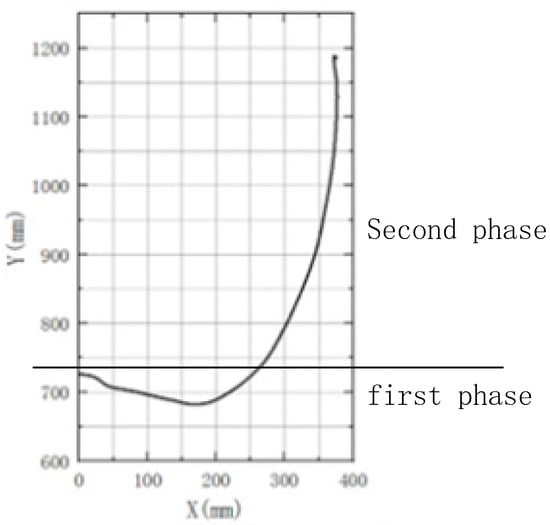
Figure 1.
Upper limb’s elbow joint trajectory during the process of the STS movement.

Table 1.
Upper limb angles during the process of the STS movement.
2.3. Structural Design
The base of the STS movement assistive device is constructed using aluminum profiles. Underneath the base, there are 8 self-locking casters that can rotate freely when not under load; when the user applies body pressure to the device, the casters automatically lock to ensure no movement occurs during use. This design satisfies the safety requirements during use and provides convenience when moving the device. There are two handrails behind the base to facilitate the user in pushing and moving the device. The base extends a certain distance towards the user, ensuring that the center of gravity of the user and the machine is concentrated within the base to effectively prevent tipping during the standing motion.
There are two handles installed on a U-shaped frame, with two serial switch buttons at the top of each handle to control the start and the stop of the entire device. The armrest is equipped with two 6 mm thick memory foam elbow pads to enhance the comfort of the user. For the elderly with poor physical function who cannot rely on their forearms to assist in standing, adjustable height armpit supports can be installed on the outside of the armrests to simulate the process of being helped to stand by a caregiver, increasing the contact area between the device and the body to ensure the effectiveness of the assistance and the stability of the standing process. However, the addition of armpit supports is not a mandatory solution, and users can choose according to their physical conditions.
The inclined guide rail system consists of a lead screw, guide rails, sliders, and a motor. The trapezoidal screw is used to transmit the lifting power, and although its transmission efficiency is relatively low, it can self-lock in the event of a power failure, ensuring the safety of the user. The two guide rails together bear most of the tipping torque during the standing process to ensure the stability of the lift.
The dimensions of the STS movement assistive device are determined according to GBT 10000-1988 “Chinese Adult Human Body Dimensions (Standard State: Current)” [23] to meet the usage of 95% percentile body sizes. Main body dimensions include a height of 178 cm, a forearm length of 26 cm, a thigh length of 50 cm, and a calf length of 40 cm. The STS movement assistive device structure is shown in Figure 2.
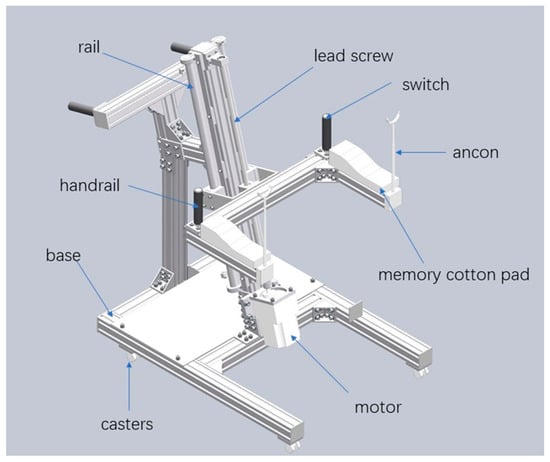
Figure 2.
STS movement assistive device structure diagram.
2.4. Driving force Calculation
The drive motor, as a key component in the design of the STS movement assistive device, directly affects whether the device can successfully assist the elderly in standing. Therefore, it is necessary to calculate the maximum load to select an appropriate motor torque and power. To reduce the occurrence of accidents, the time taken to assist the elderly in standing should not be too fast [24].
The power of the device is provided by a motor, which is directly connected to the trapezoidal screw through a coupling. After the motor starts, it drives the screw to rotate, thereby lifting the screw nut and moving the support mechanism diagonally upwards. This lifting mechanism is simple in structure, low in manufacturing cost, and has reliable safety.
The design maximum lifting weight is 100 kg, with the track inclined at an angle θ = 73.732° and the load along the guide rail direction:
The minimum output torque of the motor should satisfy the following equation:
where T is the minimum torque required by the motor, F is the maximum load lifted along the guide rail direction, P is the lead of the screw, and η is the screw transmission efficiency.
For safety, a safety factor of 2 is applied during the start and stop stages:
T = 3.056 N × m.
Healthy adults typically require approximately 1.5 s to stand, whereas elderly individuals may need a longer time to perform the same action. This device offers an adjustable stand-assist time between 2 and 8 s through the regulation of the motor speed, allowing users to customize the duration of the standing process based on their specific needs and capabilities.
3. Biomechanical Simulation
Before constructing a prototype, it is necessary to perform dynamic simulations [24] to verify the rationality of the structural design and the effectiveness of the assistance provided by the stand-up aid device [25]. Within the ADAMS-LifeMOD environment, a human-machine model was constructed to study the operational performance of the STS movement assistive device during actual work. This helps to identify and resolve issues early on, thereby shortening the design cycle.
3.1. Simulation Based on ADAMS-LifeMOD
Due to the relatively complex structure of the STS movement assistive device, the model is directly imported from Solidworks into Adams. Before importing, the 3D model of the STS movement assistive device is simplified by removing components unrelated to motion to reduce the number of parts in the model. An excessive number of components would require a large amount of constraints, which would directly affect the solving speed in Adams. After the simplified model is imported into Adams, Boolean operations are first used to merge some parts to further increase the solving speed. Next, constraints related to the STS movement assistive device and its moving pairs are added, along with the driving force of the motor. Once the stand-up aid device model is set up, a human body model with 19 segments and 18 joints is established using LifeMOD. Body information is imported from the GoBOD database, setting the model height at 177 cm and weight at 77 kg. Then, each joint of the human body is established one by one, the corresponding soft tissue models are created, and the slf format STS movement motion data of the human body model are imported. Finally, contact forces between the soles of the feet and the ground, as well as between the arms and the STS movement assistive device, are added.
Inverse dynamic simulations are conducted using the imported motion data, recording the movement angles of each joint and automatically creating functions for forward dynamics. Adams motion model is shown in Figure 3. Subsequent forward dynamic simulations are performed to obtain the torque of each joint of the human body as well as the contact forces between the body and the environment. The entire process of Adams LifeMOD simulation is illustrated in Figure 4.
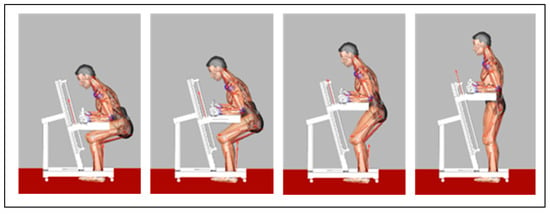
Figure 3.
Adams simulation of the STS movement animation.
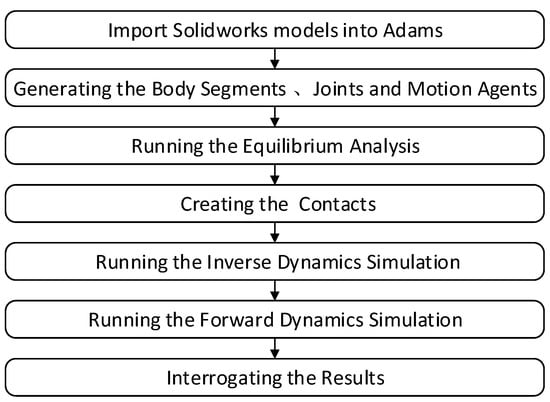
Figure 4.
ADAMS-LifeMOD simulation process.
3.2. Simulation Results of the Lower Limb Joint Torque
With the provided assistance, different levels of assistance were set at 0%, 10%, 20%, 30%, 40%, and 50% of body weight. Through simulation calculations, the torque values for the knee joint, the hip joint, and the ankle joint were obtained. In the graph, the horizontal axis represents the STS movement cycle, while the vertical axis represents the joint torque. Different colors were employed to distinguish results under various assistive levels. The biomechanical simulation results are shown in Figure 5.
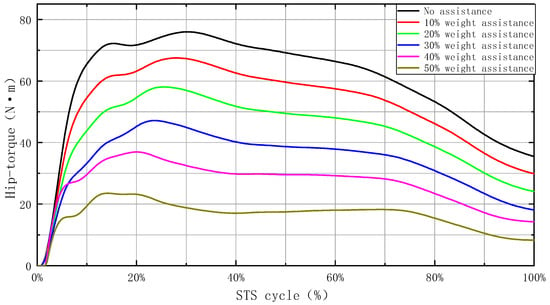
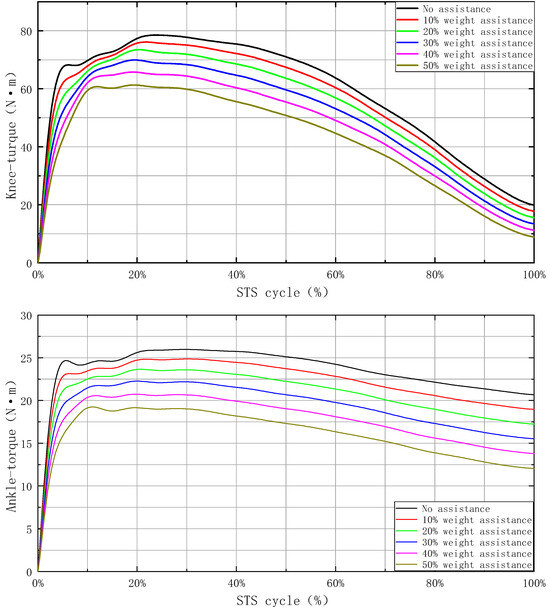
Figure 5.
The torques of the hip joint, the knee joint, and the ankle joint from top to bottom.
The simulation results of the lower limb joint torques are consistent with the torque trends presented in the related literature [26]. From the start of the standing-up action to 20% completion, the joint torque experienced a rapid increase phase corresponding to the acceleration phase of the body’s center of gravity. The lower limb joint torque showed a trend of rapid increase followed by a slow decrease. With the increase in upper limb assistance ratio, the torques of the ankle, the knee, and the hip joints all decreased, indicating that the STS movement assistive device has successfully reduced the load on the lower limb joints. Notably, the upper limb assistance was most effective in reducing the hip joint torque. Although the knee and the ankle joint torques decreased, the extent of the reduction was limited.
3.3. Simulation Results of Plantar Pressure
Figure 6 displays simulation results, where the horizontal axis represents the STS motion cycle and the vertical axis represents the contact force between the foot sole and the ground. Results for different assistance levels were distinguished using different colors.
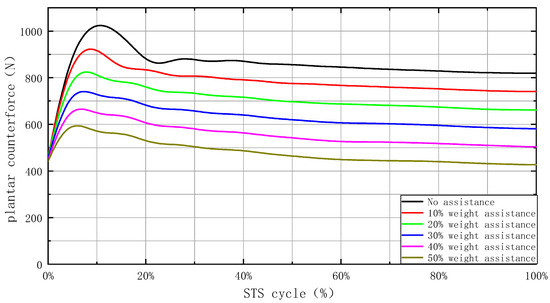
Figure 6.
Comparison of plantar counterforces under different assistive forces.
The simulation results show that the plantar pressure went through a process of being stable, increasing, and then stabilizing again, corresponding to the preparatory body lean phase of the STS movement, the accelerating rise phase of the body’s center of gravity, and the phase where the rising of the body’s center of gravity slows down and stabilizes, respectively. As the assistance from the STS movement assistive device increased, the pressure on the soles of the feet continuously decreased, indicating that part of the body’s weight was shared by the upper limbs.
4. Prototype and Experiment
4.1. Purpose of the Experiment
To further validate the effectiveness of the STS movement assistive device, based on the existing structural design and dynamic simulation, we constructed an experimental prototype using industrial aluminum profiles. The changes in plantar pressure were measured using a load cell and compared with simulation results to verify the reliability of the simulation. At the same time, a questionnaire survey was conducted to inquire about the volunteers’ feelings during use, to gain a deeper understanding of the comfort level during actual use. This comprehensive verification method helps to fully assess the performance and user experience of the STS movement assistive device.
After completing the hardware platform for the control system of the experimental prototype, to avoid unnecessary device damage and personnel injury during the loading experiment, it is first necessary to perform no-load debugging of the system. This step helps to verify that the design of the control circuit is correct and error-free and ensures normal system communication. Through no-load debugging, potential problems can be identified before actual loading, improving the safety and stability of the device operation.
4.2. Experimental Design
Measuring plantar pressure is crucial for evaluating the performance of devices designed to assist with standing and their interaction with users. This measurement provides essential data for verifying the functionality of the device, allowing for the direct assessment of its assistive efficacy by comparing changes in plantar force before and after the device use. Furthermore, by analyzing the rhythm of the user’s STS movements before and after using the device, it is possible to confirm whether the device correctly assists users as intended by its design. Quantitative analysis of plantar pressure ensures that the evaluation of the device’s performance is not solely based on subjective feedback from users.
To capture the variations in vertical plantar pressure during the STS movement, a force-measuring platform was constructed. This platform included parallel beam weighing sensors, a digital signal transmitter, communication lines, and a computer. The parallel beam weighing sensor, as the core component of the system, measured force by utilizing the minor deformations that occurred within its elastomer under force. These deformations caused changes in the resistance value of strain gauges on the surface of the elastomer, which were then converted into voltage signals proportional to the applied force through a Wheatstone bridge circuit, achieving precise measurement. The key parameters of the sensor are shown in Table 2. This sensor offered several advantages, such as high output sensitivity, insensitivity to the location of the load point, and excellent consistency, all contributing to the accuracy and reliability of the measurements. The sensor’s parameters are detailed in Table 3. The digital signal converter was responsible for amplifying and converting an analog signal into a digital signal, which was then transmitted to the computer via a 485-communication line. To ensure the accuracy of measurements, the sensor was calibrated before the experiments. The sensor connection method is shown in Figure 7.

Table 2.
Main technical parameters of parallel beam weighing sensors.

Table 3.
The heights and weights of volunteers.
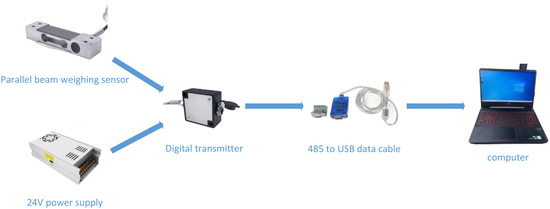
Figure 7.
Schematic diagram of load cell experiments.
To ensure the safety of the experiment, we first conducted experiments on the assistive effect of the STS movement assistive device for young people. We recruited volunteers from our school and collected the following height and weight information of the volunteers. The information of volunteers is shown in Table 3.
The comfort level of users is an important indicator when evaluating practical effects. However, comfort often depends on the user’s own physical condition and subjective feelings, making it difficult to accurately display through quantitative means. Therefore, we decided to use a questionnaire to evaluate. The questionnaire mainly covered the following aspects: whether there is a feeling of being dragged, whether it subjectively feels labor-saving, and whether the use is convenient, etc. Through these subjective feedback, we could more comprehensively understand the users’ feelings during the experiment, providing a reference for further improving the performance of the device.
4.3. Experimental Steps
Step one: Train volunteers in the motion of standing up to ensure that the subjects stand up in a natural motion, eliminating interference from other factors [27]. A uniform sitting posture with a starting knee angle of 90 degrees is specified, and the thighs must remain horizontal, as shown in Figure 8.
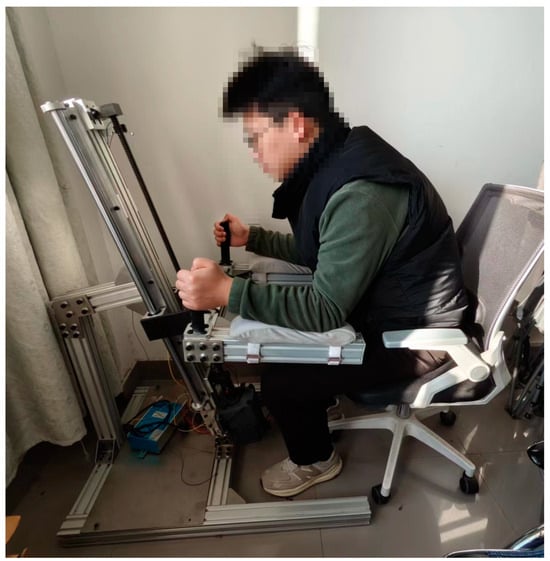
Figure 8.
Experiment on the assisting effect of the STS movement assistive device.
Step two: The volunteer sits on a stool with both feet on the pressure sensors to begin collecting pressure data. Without using the STS movement assistive device, the volunteer leans forward and then stands up slowly and steadily. The entire standing motion must be completed coherently without the upper limbs leaning on any object. Each volunteer must complete the action multiple times. The plantar pressure signals from multiple standing motions are filtered to eliminate problematic experimental data, which represent the plantar pressure during the standing process without assistance. Between multiple collections, volunteers should be allowed to rest appropriately to eliminate the impact of physical fatigue on the standing action.
Step three: The volunteer sits on a stool with both feet on the pressure sensors to begin collecting pressure data. The volunteer uses the STS movement assistive device, leans forward, grasps the handrails with both hands, rests the forearms on the elbow supports and then stands up slowly and steadily. Similarly, each volunteer must complete the action multiple times. The plantar pressure signals from the 5 standing motions are filtered to remove problematic experimental data, and then the average value is taken, which represents the plantar counterforce during the standing process with assistance. Between multiple collections, allow volunteers to rest appropriately to eliminate the fatigue effect on the standing action.
Step four: Compare the two sets of collected data to analyze the weight reduction effect of the STS movement assistive device and distribute questionnaires to the volunteers.
Step five: Repeat the above experimental process to collect plantar pressure data from other volunteers.
4.4. Experimental Results
To compare and analyze the changes in plantar counterforce during the standing-up process, the percentage of the standing-up action completed was used as the abscissa, and the plantar pressure was used as the ordinate. At the same time, the data collected from the unassisted self-standing process and the STS movement assistive device were plotted on the same graph. Such a graph can intuitively display the trend of changes in plantar counterforce under both conditions, facilitating further analysis and comparison.
Due to variations in individuals’ rising movements and differences in physical parameters such as height and weight, the results obtained from the weight sensor may vary. As illustrated in Figure 9, the changes in the pressure on the foot during the standing-up process are shown for four volunteers. The horizontal axis represents the rising period, while the vertical axis represents the pressure of the foot on the ground. To present the experimental results more clearly, different colors were used to distinguish the pressure results obtained from the two rising methods.
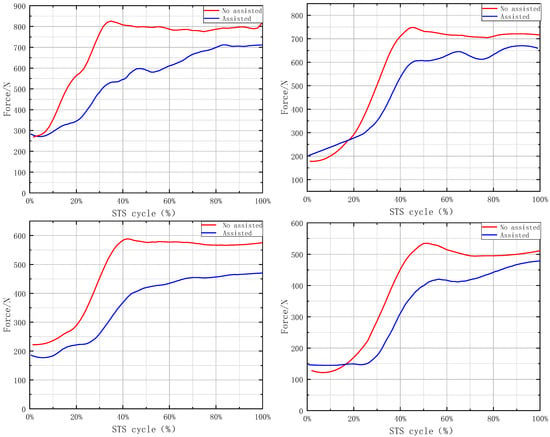
Figure 9.
Comparison of plantar force (experimental value).
By observing four groups of pressure curves, it can be found that without assistance, the plantar pressure during the standing-up process shows a rapid surge, followed by a gradual stabilization. In contrast, with assistance, the trend of plantar pressure change was basically consistent with the unassisted trend, but during the standing-up phase, the rate of increase in plantar pressure was significantly slowed, and the peak value of plantar pressure was significantly lower than that without assistance.
It is evident that the STS movement assistive device can effectively slow down the rapid changes in plantar pressure during the standing-up phase, reducing the impact on the joints of the lower limbs during the standing-up process. The STS movement assistive device reduced the plantar pressure throughout the STS movement, and compared to unassisted standing, the volunteer’s lower limb stress was improved. The STS movement assistive device played a positive role in helping volunteers in the standing-up process. It is worth noting that some volunteers’ data showed slightly higher plantar pressure at the beginning of the assisted standing movement compared to that under the unassisted situation, which may be the result of the volunteers’ bodies spontaneously adjusting their center of gravity and adapting to the STS movement assistive device.
All four volunteers indicated that the STS movement assistive device had the expected effect and they did not feel any discomfort during the STS movement, and the standing-up process was more effortless. These questionnaire results suggest that the STS movement assistive device successfully achieved the intended design effect and received positive feedback from volunteers during actual use.
5. Discussion
Compared to other lifting devices, this apparatus similarly aids elderly individuals in transitioning from sitting to standing but aligns more closely with natural standing habits and is more convenient to use. On one hand, the standing assist device proposed by Bulea in 2012 [20] exerts force in a vertical upward direction, whereas our device applies force in an upward and inclined direction, better matching the biomechanical patterns of healthy individuals’ standing motions. On the other hand, most other lifting devices require being fixed to the body, offering greater assistance in standing but also featuring more complex attachments to the body, making quick disengagement challenging. These devices are better suited for individuals with severe physical functional decline. Our device, however, is designed for elderly individuals with mild physical functional decline, balancing assistance with a more convenient mode of operation, while also enhancing the stability of the standing action.
Human movement and force application are intuitive and directly measurable, whereas joint torque is challenging to measure directly. Typically, the acquisition of joint torque is facilitated by biomechanical simulation software. The torque at human joints can be considered as generated through the transmission of plantar pressure from the bottom upwards. Therefore, as plantar pressure decreases, the torque at the lower limb joints also diminishes, suggesting that the magnitude of plantar pressure can, to some extent, represent the force condition of the lower limbs. Although this study involves both measurement and simulation of plantar pressure, there was no direct correlation between the two. In the simulation work of this study, it was assumed that the force experienced by the arms was constant, exploring the changes in joint forces by applying different magnitudes of force to the arms. The results indicate that a smaller applied force significantly reduced the force on the hip joint. In the experimental work, from the perspective of practical use, changes in plantar pressure during the standing process were measured. The findings show that using this device to stand reduces plantar pressure, thus improving the force condition on the lower limb joints. It was also observed that the force experienced by individuals’ arms varied, and the force on the arms was not constant at different times. Therefore, the plantar pressures obtained from simulation and those from experiments were not the same, and these two sets of results did not contradict each other.
For a clearer expression, the four experimental results were standardized and plotted in the same graph, as shown in Figure 10. The vertical axis is the force value divided by the volunteer’s weight. The simulated plantar pressure increased from the initial moment, while the experimentally measured plantar pressure had a relatively gentle change at the initial moment. The reason for this difference is that the actions intercepted by the simulation were the second stage of the human body standing up quickly. The plantar pressure collected in the experiment included the first stage of preparation for standing up and the second stage of the human body standing up quickly. From the experimental results, it was observed that the reduction in plantar pressure during the standing-up process significantly reduced with the assistance of the upper limbs. The percentage of reduction in plantar pressure varied for each volunteer, which was consistent with individual differences. This percentage should not be fixed, and the specific reduction should be based on the user’s comfort level. Each person’s upper and lower limb strengths were different, and there was no uniform standard for the compensation effect. Different users needed to actively adapt and actively complete the standing-up action. This is in line with the initial intent of the design of the STS movement assistive device, which is to provide some assistance for the STS movement, but the entire action is still actively completed by the user, rather than passively standing up by having the body weight entirely on the STS movement assistive device. The STS movement assistive device is not only for reducing the load on the lower limbs but also for improving the stability of the body during the STS movement.
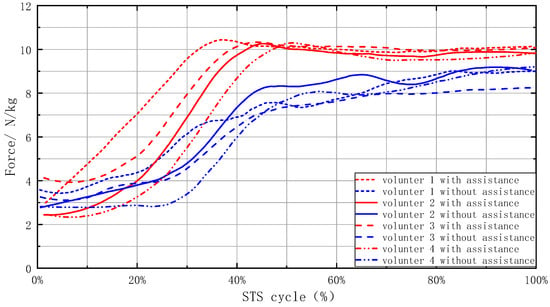
Figure 10.
Plantar forces of four volunteers.
By comprehensively comparing the results of simulations and experiments, it was found that the trend of plantar pressure changes collected by pressure sensors was basically the same as that obtained from simulations, which further strengthens the reliability of the simulation results. In the simulation results, as the upper limbs bore more weight, the reduction in the biometric torque of the hip joint was the most significant. The use of assistance was most evident in protecting the hip joints of the elderly. This suggests that for elderly people with degenerative hip joint function, the help from this device may be more significant.
This STS movement assistive device was primarily designed to aid elderly individuals with mild lower body functional decline in standing up. It may not be suitable for elderly groups with severe upper limb functional deterioration. The process of assisting in standing is similar to a caregiver helping an elderly person to stand, where the device not only reduces the load on the lower limbs but also enhances the stability of the sit-to-stand movement. During the experimental process, a significant decrease in plantar pressure was observed when comparing unassisted standing to standing with the use of the sit-to-stand assistive device. The movement speed during standing was slow enough to neglect the inertia of the limbs; thus, the difference between the two plantar pressure approximated the force exerted on the arms. Data from four experiment participants indicate that each experienced different levels of arm force, especially when comparing the first and second individuals. Individuals with stronger upper limbs tended to voluntarily bear more force on their arms during use. Conversely, those with weaker upper limbs shared less force. In practical use, the forces that different elderly individuals can bear on their upper limbs vary, and compared to that for younger individuals, the proportion of this force to their own weight may decrease. The speed of the assistive device is slightly slower than the natural standing speed, allowing users to adjust the force shared by their arms based on their physical conditions autonomously.
6. Conclusions and Future Work
Providing assistance to elderly people with degenerative bodily functions during the STS movement is essential. To reduce the occurrence of accidents during the STS movement, this paper, based on the study of the standing-up trajectory of healthy individuals, has designed an STS movement assistive device aimed at providing assistance during the STS movement, enhancing the stability of the elderly and achieving the function of helping the elderly improve the load on their lower limbs and increase body stability. The effectiveness of the STS movement assistance was verified through ADAMS-LifeMOD simulation, providing theoretical support for the design of the device. Finally, a prototype was manufactured, and four volunteers were invited to test it to further verify the assistive effect and user comfort.
In future work, we plan to integrate more functions, such as alarms and automatic routing in case of accidents. In addition, we will further refine the product’s appearance design and optimize the materials, dimensions, and human−machine interaction modes of each component. Ultimately, under the premise of ensuring safety, we plan to invite more elderly people with degenerative lower limb functions to participate in trials and further improve the device based on experimental results. These improvements will help enhance the functionality and practicality of the device and better meet the needs of the elderly.
Author Contributions
Conceptualization, X.Z. and Y.L.; methodology, Y.X. and B.Z.; validation, Y.L., R.G., P.C. and X.Z.; formal analysis, Y.X. and B.Z.; investigation, B.Z. and S.Z.; resources, Y.X.; data curation, B.Z.; writing—original draft preparation, B.Z.; writing—review and editing, Y.X.; visualization, Y.X. and B.Z.; supervision, Y.L., R.G. and P.C.; project administration, Y.X. and X.Z.; funding acquisition, X.Z. All authors have read and agreed to the published version of the manuscript.
Funding
This research was funded by the Beijing Academy of Science and Technology Innovation Engineering Program grant number 24CA009-03.
Institutional Review Board Statement
The study was conducted according to the guidelines of the Declaration of Helsinki, and approved by the Zhengzhou University Life Sciences Ethics Review Committee (protocol code ZZU-LAC20230331[09]).
Informed Consent Statement
Informed consent was obtained from all subjects involved in the study.
Data Availability Statement
Data are unavailable due to privacy or ethical restrictions.
Conflicts of Interest
The authors declare no conflicts of interest.
References
- Etnyre, B.; Thomas, D.Q. Event Standardization of Sit-to-Stand Movements. Phys. Ther. 2007, 87, 1651–1666. [Google Scholar] [CrossRef]
- Robinovitch, S.N.; Feldman, F.; Yang, Y.; Schonnop, R.; Leung, P.M.; Sarraf, T.; Sims-Gould, J.; Loughin, M. Video Capture of the Circumstances of Falls in Elderly People Residing in Long-Term Care: An Observational Study. Lancet 2013, 381, 47–54. [Google Scholar] [CrossRef] [PubMed]
- Shaw, B.H.; Claydon, V.E. The Relationship between Orthostatic Hypotension and Falling in Older Adults. Clin. Auton. Res. 2014, 24, 3–13. [Google Scholar] [CrossRef] [PubMed]
- Appeadu, M.K.; Bordoni, B. Falls and Fall Prevention in Older Adults. In StatPearls; StatPearls Publishing: Treasure Island, FL, USA, 2023. [Google Scholar]
- Rodrigues, F.; Monteiro, A.M.; Forte, P.; Morouço, P. Effects of Muscle Strength, Agility, and Fear of Falling on Risk of Falling in Older Adults. Int. J. Environ. Res. Public Health 2023, 20, 4945. [Google Scholar] [CrossRef]
- Liang, X.; Chen, F. A Study on Design of Adaptive Assistant Devices for the Sit-To-Stand. In Proceedings of the 2021 IEEE International Conference on Power, Intelligent Computing and Systems (ICPICS), Shenyang, China, 29–31 July 2021; pp. 196–201. [Google Scholar]
- Sam, R.Y.; Lau, Y.F.P.; Lau, Y.; Lau, S.T. Types, Functions and Mechanisms of Robot-Assisted Intervention for Fall Prevention: A Systematic Scoping Review. Arch. Gerontol. Geriatr. 2023, 115, 105117. [Google Scholar] [CrossRef] [PubMed]
- Tu, W.-J.; Zeng, X.; Liu, Q. Aging Tsunami Coming: The Main Finding from China’s Seventh National Population Census. Aging Clin. Exp. Res. 2022, 34, 1159–1163. [Google Scholar] [CrossRef] [PubMed]
- Nakamura, K.; Saga, N. Current Status and Consideration of Support/Care Robots for Stand-Up Motion. Appl. Sci. 2021, 11, 1711. [Google Scholar] [CrossRef]
- Chen, B.; Zhong, C.-H.; Zhao, X.; Ma, H.; Guan, X.; Li, X.; Liang, F.-Y.; Cheng, J.C.Y.; Qin, L.; Law, S.-W.; et al. A Wearable Exoskeleton Suit for Motion Assistance to Paralysed Patients. J. Orthop. Transl. 2017, 11, 7–18. [Google Scholar] [CrossRef] [PubMed]
- Suzuki, K.; Mito, G.; Kawamoto, H.; Hasegawa, Y.; Sankai, Y. Intention-Based Walking Support for Paraplegia Patients with Robot Suit HAL. Adv. Robot. 2007, 21, 1441–1469. [Google Scholar] [CrossRef]
- Wu, X.; Liu, D.; Liu, M.; Chen, C.; Guo, H. Individualized Gait Pattern Generation for Sharing Lower Limb Exoskeleton Robot. IEEE Trans. Autom. Sci. Eng. 2018, 15, 1459–1470. [Google Scholar] [CrossRef]
- Massardi, S.; Pinto-Fernandez, D.; Babič, J.; Dežman, M.; Trošt, A.; Grosu, V.; Lefeber, D.; Rodriguez, C.; Bessler, J.; Schaake, L.; et al. Relevance of Hazards in Exoskeleton Applications: A Survey-Based Enquiry. J. Neuroeng. Rehabil. 2023, 20, 68. [Google Scholar] [CrossRef]
- Cao, E.; Inoue, Y.; Liu, T.; Shibata, K. A Sit-to-Stand Training Robot and Its Performance Evaluation: Dynamic Analysis in Lower Limb Rehabilitation Activities. J. Syst. Des. Dyn. 2012, 6, 466–481. [Google Scholar] [CrossRef]
- Rea, P.; Ottaviano, E. Functional Design for Customizing Sit-to-Stand Assisting Devices. J. Bionic. Eng. 2018, 15, 83–93. [Google Scholar] [CrossRef]
- Zhou, B.; Xue, Q.; Yang, S.; Zhang, H.; Wang, T. Design and Control of a Sit-to-Stand Assistive Device Based on Analysis of Kinematics and Dynamics. Automatika 2021, 62, 353–364. [Google Scholar] [CrossRef]
- Rea, P.; Ruggiu, M.; Ottaviano, E. Synthesis and Prototyping of a Sit-to-Stand Assisting Device. Machines 2024, 12, 33. [Google Scholar] [CrossRef]
- Afsar, M.R.; Ashiquzzaman, A.; Martelli, D.; Shen, X. SW-SiStA2: A New-Generation Semi-Wearable Device for Sit-to-Stand Assistance. J. Med. Devices 2023, 17, 031001. [Google Scholar] [CrossRef]
- Purwar, A.; Bhargava, K.; Behan, E. A Multi-Functional Mobility Assist Device for Sit-to-Stand Motion. Int. J. Ind. Ergon. 2023, 93, 103396. [Google Scholar] [CrossRef]
- Bulea, T.C.; Triolo, R.J. Design and Experimental Evaluation of a Vertical Lift Walker for Sit-to-Stand Transition Assistance. J. Med. Devices 2012, 6, 014504. [Google Scholar] [CrossRef]
- Eto, H.; Nakamoto, H. Development of an Elbow-Supporting Device to Assist Standing-up Motion. Robomech. J. 2015, 2, 10. [Google Scholar] [CrossRef]
- Motion Database HDM05. Available online: https://resources.mpi-inf.mpg.de/HDM05/index.html (accessed on 9 January 2024).
- GB/T 10000-1988; Standardization Administration of the People’s Republic of China. Human Dimensions of Chinese Adults. Standardization Administration of the People’s Republic of China: Beijing, China, 1988.
- Wang, H.; Fu, J.; Mei, L.; Xu, X.; Xu, S.; Wang, Z.; Na, R.S. Study of Speed and Angle during Safe and Comfortable Standing of Elderly People. Robot. Intell. Autom. 2023, 43, 443–454. [Google Scholar] [CrossRef]
- Liu, Y.; Gao, Y.; Zhu, Y. A Novel Cable-Pulley Underactuated Lower Limb Exoskeleton for Human Load-Carrying Walking. J. Mech. Med. Biol. 2017, 17, 1740042. [Google Scholar] [CrossRef]
- Yang, J.; Ozsoy, B. Three Dimensional Unassisted Sit-to-Stand Prediction for Virtual Healthy Young and Elderly Individuals. Multibody Syst. Dyn. 2020, 49, 33–52. [Google Scholar] [CrossRef]
- Han, X.; Xue, Q.; Yang, S.; Zhang, S.; Li, M. Effect of Different Handrail Types and Seat Heights on Kinematics and Plantar Pressure during STS in Healthy Young Adults. Medicine 2021, 100, e28091. [Google Scholar] [CrossRef] [PubMed]
Disclaimer/Publisher’s Note: The statements, opinions and data contained in all publications are solely those of the individual author(s) and contributor(s) and not of MDPI and/or the editor(s). MDPI and/or the editor(s) disclaim responsibility for any injury to people or property resulting from any ideas, methods, instructions or products referred to in the content. |
© 2024 by the authors. Licensee MDPI, Basel, Switzerland. This article is an open access article distributed under the terms and conditions of the Creative Commons Attribution (CC BY) license (https://creativecommons.org/licenses/by/4.0/).